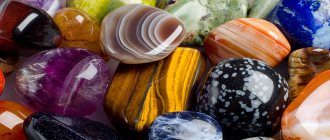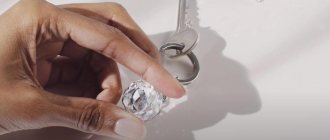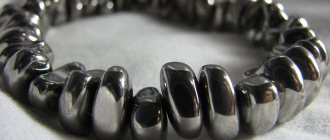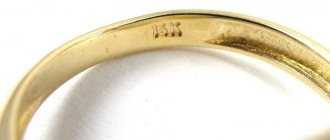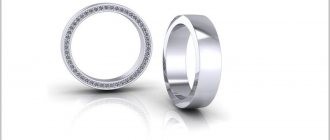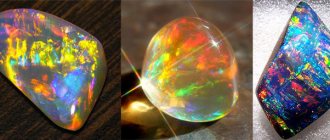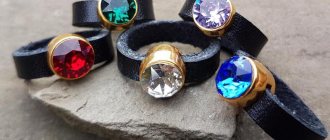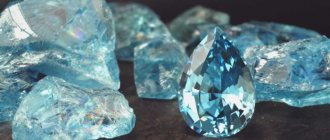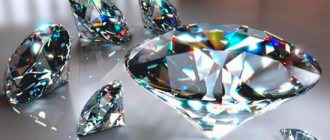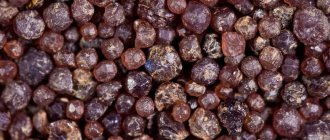Planet Earth contains treasures of minerals, as well as countless unique and beautiful minerals. Thanks to tectonic processes, they are formed over millions of years. Some of them do not bring any benefit and are not even of any interest to the jewelry industry. But some are considered very expensive gems and belong to the group of precious stones.
Some of these crystals are ruby, also known as yakhont in ancient times, and garnet. The minerals are very similar to each other. But jewelry lovers often have a question: “Which is more expensive: a ruby or a garnet and how to distinguish between them?” Let's try to understand this issue.
Ruby or garnet: which is actually more expensive?
Hello, dear readers and guests of the site!
An ignorant person sometimes cannot distinguish between minerals that look similar and is deceived when purchasing. To prevent such an incident from happening, we will teach you how to distinguish twin stones from each other. And our first online lesson is dedicated to two beautiful specimens. “Ruby or garnet – which is more expensive,” fans of red gems often ask. They seem to look the same, so it won’t take long to confuse them, which means you’ll end up overpaying. Or maybe they are equivalent in jewelry? Let's figure it out. If you have already visited us, then you are probably interested in the history and characteristics of the most famous and popular precious stones. Among them there are real treasures, expensive, elegant, alluring with their brilliance and rich color. There are also less valuable stones, slightly inferior in their characteristics.
Refined rubies
To give a natural mineral greater transparency, enhance color, create or enhance optical effects, rubies are refined. For this use:
- high temperature treatment;
- surface diffusion;
- filling cracks with dyes or a colorless substance;
- foil linings;
- irradiation.
In most cases, rubies become more attractive after refining. Sometimes glass-like particles may appear or defects may expand.
Treated stones are natural, but are valued lower than untreated stones, closer to synthetic ones.
Noble ruby and rustic garnet
Our planet is very generous with deposits of nugget stones. Tectonic processes in its depths are a continuous phenomenon, which means thousands of new minerals are born every day. Some of them are already loved and known for their aesthetic qualities. For example, ruby and garnet, which have been decorating the fingers, wrists, and necks of beautiful ladies for many centuries. The expressive bright color of both is their main advantage, but it is also an obstacle to their differentiation. How to distinguish a ruby from a garnet and is it possible for a “non-specialist” to do this by eye?
Let's agree right away. A ruby will cost you many times more than a more rustic garnet. Many scientists compare it in value to a diamond and do not even want to put it on the same level as garnet jewelry.
The blood-red ruby, which refracts rays of light into a rainbow, is a stone of dazzling beauty, especially highly valued among jewelers. It is found in North Africa and southeastern Asia. They say that blood rubies can reach exorbitant prices.
This is interesting! The ancient name for ruby is red yakhont. On the Mohs scale of mineral hardness it is only one position behind diamond. Chromium inclusions give it its rich red color. However, ruby can have other interesting colors. Few people know, but blue sapphire is also from the ruby family.
Ruby, despite its external sophistication, is used not only in jewelry, but also for industrial purposes. For example, the production of expensive watch movements is unthinkable without the inclusion of parts from this mineral. It is very durable and can withstand the strongest electromagnetic loads.
Imitation ruby
Composite stones are considered fake rubies. For example, a thin almandine plate is glued onto red glass. Examining the sample under a magnifying glass will reveal a bond line, or a change in gloss visible from a certain angle at the boundary between glass and garnet. Placing a sample in liquid will also help us find out if it is a fake. The doublet will give itself away as a straight line of connection.
You can distinguish a ruby from glass under a magnifying glass or microscope by gas bubbles and color funnels.
Rhinestones have a single light refraction, and the refractive indices do not correspond to the refraction of the gemstone. But glass can be confused with garnet and spinel based on this indicator.
You can distinguish a real stone from a fake mechanically: by running a file over the stone. A visible mark will remain on the glass or plastic. But what about ruby?
What is different about pomegranate?
The richest ruby deposits are found in cold Antarctica, but searching for minerals there is quite difficult. Therefore, stones began to be mined in Asia and African countries. Even the ancient Indians hunted for the gem in order to build a powerful amulet from it. They believed that it perfectly protected against the evil eye, illness and even death.
Nowadays, rubies are valued mainly for their aristocratic, conspicuous appearance and are often used in exquisite jewelry.
Pomegranate is visually difficult to distinguish from its more expensive “brother”. It also comes in a vibrant red or pink color. However, in terms of density, garnet is 3 units lower than ruby (6 on the Mohs scale). It is not used in electronics, since it cannot withstand electromagnetic waves and is destroyed. But in the jewelry industry it is in great demand. The famous garnet beads, necklaces, and earrings are perfect for ladies with strong energy and charisma who want to stand out and gain unique charm.
Deposits of garnet deposits in our country are concentrated in the Urals. Do you want to see pomegranate in its original form? Visit the Ural town of Saranovsk. The local garnets look clean and neat even without additional processing. Local residents called it uvarite and are very proud that such a miracle is born in their vicinity.
By the way, pomegranate, like the berry of the same name, occurs in the form of small grains. It practically never occurs alone in nature. To remove one stone from a granular plate, you will have to completely destroy the entire texture. Just like sweet pomegranate fruits, right? Perhaps the name of the mineral was given by its resemblance to everyone’s favorite berry.
Due to the striking similarity to a ruby, many jewelry workshops profit from the ignorance of buyers and pass off an inexpensive garnet as a more valuable ruby. Even experienced mineralogists sometimes cannot find the differences, because it is impossible to do this by eye. You can only rely on your intuition and the cleanliness of the manufacturer.
Interesting experiments
It is most likely that similar minerals can be distinguished only with the help of special high-precision equipment. Do you have this? We assume that no, and therefore we will determine how a ruby differs from a garnet using available and available means.
For this you will need:
- UV lamp;
- strong magnifying glass;
- magnet;
- dichroscope;
- scales with high accuracy (electronic kitchen or pocket scales are also suitable).
The main difference between these two stones is the ability or inability to dichroism. What it is? This is a unique property found only in rubies. Air polarized by a dichroscope can change the color of rubies. What it will be like depends on the angle of light falling on it.
A grenade will not respond to such a device, but it will quickly respond to magnetic waves. Crystals of this mineral are easily “charged” from the most ordinary magnet. No, the stone will not be attracted to it, but by touching it or lying next to it, it will “gain” a little weight. Carry out an experiment: place a magnet near a pomegranate for a couple of minutes and weigh it. If the mass has increased, this is definitely not a ruby.
Does an artificial mineral have healing and magical properties?
Natural ruby is valued not only for its beauty, but also for its magical properties, including attracting wealth and good luck in love, helping to wisely lead people. The healing effect of the mineral is also high.
Another thing is imitation ruby. There is no magical energy in glass or plastic, in crystals grown from salt or sugar.
The properties of a composite ruby, that is, an alloy of glass and a real ruby component, allow us to talk about its effect on the owner. However, this effect is less pronounced than the influence of a natural gem.
Artificial stone, that is, grown in laboratory conditions, has more modest healing and magical properties. Although disputes on this matter do not stop.
Visual and other means of differentiation
A ruby costs several times more than a garnet. Often a cheaper stone replaces a precious crystal in jewelry. Only a jeweler can accurately determine the type of stone. But if you have instruments such as a dichroscope, a magnet, a magnifying glass, an ultraviolet lamp and high-precision electronic scales, you can try yourself as an expert.
How to test minerals:
- Take a dichroscope (a device for detecting two-colors) and direct a beam of its color onto the crystal. If the shade changes from light to dark, this is a sign of a ruby. Pyropes do not have pleochroism, so they do not change the saturation of the shade under the beam.
- If you illuminate a ruby with an ultraviolet lamp, the inside of the specimen will glow orange. This property is called luminescence. Pyropes do not have it.
- In a real ruby, when viewed through a microscope, inclusions in the form of tubes can be seen. Pomegranate has a homogeneous structure.
- All corundums have a high hardness rating, so they can easily scratch topaz or crystal, rated 8 points. If you try to damage these minerals with a garnet, the attempt will be unsuccessful, since this stone is assigned 7 points.
- The ruby shines and shines like a diamond. Garnet is characterized by a less pronounced shine.
- If you bring pyrope to a magnet, it will be attracted because it contains iron impurities. Ruby is aluminum oxide with chromium, so it is not magnetic. However, a less valuable mineral may be low in iron, which is why the magnetic properties will not be clearly visible. In this case, the specimen should be placed on a high-precision scale and a magnet should be held up. If the mass changes, then this is a sign of pomegranate.
Important! If there is no special equipment at home, the gem of interest should be taken to a gemologist for examination.
Garnet is a gem accessible to everyone
The gem belongs to the class of silicates. It is distinguished by a crystal lattice, giving the stone a square shape. After processing, the pomegranate becomes any shape, but retains its beautiful red color.
In nature, garnet ranges from pale red to a rich color similar to ruby. The hardness of the mineral is lower than that of its “brother”, only 6.5-7.5 points on the Mohs scale. When a stone splits, the surface of the fragments will be uneven.
You can distinguish a natural garnet from a similar fake by its ability to become electrified. If you rub a piece of jewelry with a gem on a woolen fabric, it can attract small pieces of paper, fluff and hair.
Among the types of garnet often used in jewelry are:
- classic almandine in red, brown or purple;
- hessonite is a yellow mineral with a sandy or orange tint;
- andradite is a red-brown type of garnet;
- Spessartine is a gemstone with a reddish, pink or yellow tint.
But, despite the breadth of choice, garnet is much cheaper than ruby. After all, the second option is less common in nature and is distinguished by its high strength and unique beauty.
How to identify a real ruby using a magnifying glass
- Just look at the sample through a magnifying glass. If the edges are clearly visible to the naked eye, then with magnification they can become unclear and blurry. This indicates the artificial origin of the stone.
- When looking at the stone through a magnifying glass, pay attention to inclusions in the form of bubbles. If they are the same color as the stone itself - red, then the sample is real. In artificial crystals, air bubbles are transparent.
- Pay attention to scratches on the surface of the stone, if any. Even shiny stripes indicate the unnaturalness of the sample under study. Scratches and cracks on original stones always appear in a zigzag pattern.
Natural ruby with inclusions
Main conclusions
- Ruby and garnet are stones that are similar to each other. It is important to distinguish them because they have different costs. Garnet is a semi-precious mineral, while ruby is a precious mineral.
- Both species have different physical and chemical properties, although they differ in appearance from each other.
- Special equipment will help you examine minerals to evaluate shade, the presence of pleochroism, and magnetization.
- Copies can be natural or synthetic. Natural fakes are cheaper substitutes that visually resemble the original crystal. Synthetic samples are made of glass and plastic.
- Genuine stones can only be purchased in specialized stores or at auctions. The seller must clarify information about the origin of the crystal and objectively evaluate the declared value.
Share your experience using ruby and garnet and leave feedback in the comments.
(3 ratings, average 5 out of 5)
